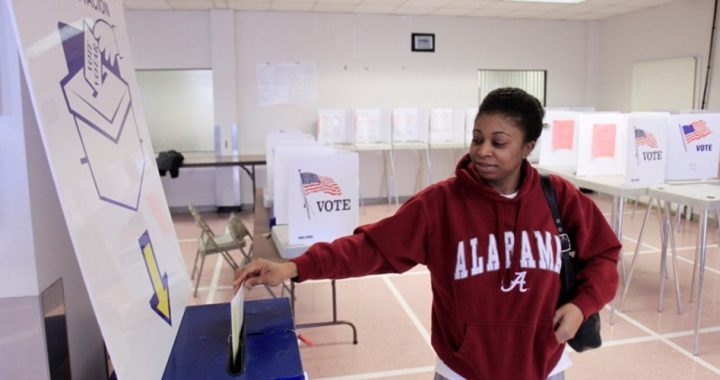
Election officials in Ohio were scheduled to begin counting absentee ballots and provisional ballots on Saturday, November 17, 2012. Despite numerous requests, The New American was unable to learn of even one exact location, date, and time of when and where these ballots were to be counted. Ohio officials are definitely not making it easy for election observers to participate in the process. And there could be good reason — on their part — for this reticence. Because the count could make a difference in election results — and maybe even highlight the likelihood of fraud.
Were Some Winners Declared Prematurely?
As of November 16, there were at least 324,462 ballots yet to be counted in Ohio — 119,535 absentee ballots and 204,927 provisional ballots. The pluralities of the two biggest contests on the ballot in Ohio this year were:
President
Barack Obama — 2,690,841 50.18%
Mitt Romney — 2,583,582 48.18%
Plurality — 107,259
U.S. Senate
Sherrod Brown — 2,640,251 50.37%
Josh Mandel — 2,361,542 45.05%
Plurality — 278,709
It’s highly unlikely that the winner of the U.S. Senate contest between incumbent Sherrod Brown and challenger Josh Mandel will change. Brown holds a 278,709 vote plurality. Mandel would need almost 93 percent of the not-yet-counted votes to win. The presidential contest is closer with Governor Romney currently trailing President Obama by 107,259 votes. That means Romney would need about 67 percent of the not-yet-counted votes to be the winner.
The winners aren’t likely to change after the absentee ballots and provisional ballots are counted, but whatever happened to the principle of not declaring a winner until the vote count got to the point where the plurality exceeded the total number of votes still uncounted? And why were there over 200,000 provisional ballots in Ohio this election?
Unbelievable Results in Cuyahoga County
The New American contacted the Cuyahoga County Board of Elections to verify news reports in other publications that have reported nine precincts in the Cleveland area with zero votes for Romney. The elections department referred TNA to a website with what appears to be a list of 1,077 precincts or sub-precincts with vote counts as of election night. The spokesman declined giving further assistance explaining the data. The data was converted to a spreadsheet format and sorted in order of Romney’s vote totals.
Cuyahoga County Precincts or Sub-Precincts with Five or Fewer Votes for Romney:
| Romney Total Per Precinct or Sub-Precinct |
Number of |
Obama Votes in Precinct |
Romney Votes in Precinct |
Other Candidates | Other Votes | Under Votes |
| 0 | 21 | 5,978 | 0 | 12 | 35 | 31 |
| 1 | 25 | 10,139 | 25 | 23 | 51 | 46 |
| 2 | 36 | 16,020 | 72 | 43 | 101 | 75 |
| 3 | 23 | 10,701 | 69 | 28 | 35 | 54 |
| 4 | 28 | 13,252 | 112 | 35 | 65 | 71 |
| 5 | 17 | 8,185 | 85 | 17 | 42 | 32 |
The heading “other candidates” includes write-ins. An over-vote is when a ballot has more votes than allowed for a given contest, such as votes for two candidates for president. In that case, the ballot is counted as zero votes for that contest. An under-vote in this case is when the ballot has no votes for any of the presidential candidates.
The 63,912 vote difference from this relatively small number of precincts comprises more half of the 107,259 state-wide vote plurality going into absentee and provisional vote counting.
What Can Citizens Do When Observing These Ballot Counts?
Citizen activists should be part of the counting process for the provisional and absentee votes, as they should have been part of election-day counts. This would keep the elections honest in many ways. In the first place, it would allow face-to-face contact with the people who had authorized access, as well incidental access, to the ballots while they were behind closed doors and provide an opportunity to get a list of names of these people.
It’s also a chance to inspect the outsides of the ballot envelopes to check for identical handwriting on the signatures and ballots. Too, observers may be able to get a list of names from the return addresses. This could be used to contact these people and ask them if they really voted or if someone just used their names to stuff the ballot box after the election.
As well, it’s a chance to ask these voters if they have been contacted by phony pollsters whose real purpose was to get a list of which way the voters voted. Dishonest people have been known to do such phony surveys of voters who send in absentee ballots in order to compile lists of which ballots to challenge at the counting and which ones to let through.
It’s also an opportunity to look at envelopes for signs of tampering. James J. Laski, Jr., former Chicago alderman and city clerk, explained in his book My Fall From Grace: From City Hall to Prison Walls, “There was an art to opening absentee ballots. In most cases, steam would be the way to go, because nobody could tell that the envelope had been tampered with after it had been resealed. Another method was to carefully use a letter opener, which required patience and skill to separate the flap from the glue and the rest of the envelope.” While Laski went on to say that not all precinct captains in Chicago were organizing government employees for such ballot tampering activities, it must be noted that some government employees are appointed to do-nothing jobs with cushy retirements for the sole purpose of reelection activities for the politicians who pulled strings to get them into those jobs. Whether that just includes political campaign activities or extends to fraud in the election depends on the scruples of the politicians and their appointees. The more the people can watch them, the better for all of us.
It’s an opportunity to look at the cancellation marks on the stamps, if used, on the absentee ballot envelopes. Unfortunately, many states allow absentee ballots to arrive after election day provided they are postmarked before election day. Postmarks are man-made and can be fraudulently applied to envelopes which can be put into outgoing mail sacks. For an example of how easily that can be done, look at the aftermath of a guess-the-score contest for the 1987 Super Bowl. Only 167 entries mailed in the correct score; 107 of them were postal employees or people associated with them.
Observers can monitor the counting to ensure the ballots are counted correctly. It’s also an opportunity, in this case, to ask why there are so many provisional ballots in Ohio this election.
Above all, it’s an opportunity for the citizens to affirm the proper relationship of government with the citizens. In traditional American elections it’s the people who own the election and the people who tell the government what to do — not the other way around.
How Open Is the Process?
American elections have traditionally used openness of the process to ensure accuracy and honesty in elections. Anyone who wanted to walk into a polling place to witness the voting or the counting was welcome to do so as long as he didn’t interfere with the voting nor violate the voter’s secrecy of the ballot where secret ballots were used. Anyone who wanted to question whether or not a voter should be allowed to vote, a process known as challenging a voter, was allowed to do so. No appointment was necessary nor were any special credentials. When the technology of photography was developed, it was also allowed. The bottom line was public access was the best disinfectant.
Ohio, like many other states, now places many restrictions on people who want to be election observers. Ohio Secretary of State Directive 2012-21, issued June 13, 2012, states:
“The following ‘appointing authorities’ are permitted to appoint observers at any primary, special, or general election:
Any political party (county or state) that is supporting candidates to be voted upon at that election
Any group of five or more candidates
A ballot issue committee recognized by the board of elections pursuant to law as supporting or opposing a ballot issue”
Note there is no provision in this directive for non-partisan groups of concerned citizens whose only purpose is to ensure accurate and honest elections.
The directive goes on to say: “An appointing authority must first notify the board of elections of the names and addresses of its appointees and the location(s) at which they will serve.… Written notification must be given to a board of elections not less than 11 days before the election on forms prescribed by the Secretary of State.”
The directive does allow for amendments until 4:00 p.m. of the day before an election, but it doesn’t allow for adding observers nor adding locations. Another way of saying this is once the list of locations has been requested 11 days prior to the election, the fraudsters can build a list of locations where election observers won’t be allowed to watch them.
Other Concerns
Human Events posted an online article on October 26 quoting volunteer poll workers as having witnessed van loads of people who were born in Somalia being assisted to vote by Democrat interpreters in Ohio. The article questioned whether or not they were citizens, as well as whether or not the assistance they got went beyond the law by also including recommendations of voting for specific candidates.
The article quoted Matt McClellan, the press secretary for Ohio Secretary of State Jon Husted, as saying: “There is a process to challenge a voter’s eligibility. The point in time for a challenge to be brought ended mid October.” If this is true, Ohio has adopted yet another weakness in the state’s electoral integrity. The New American contacted the Ohio Secretary of State’s office to confirm whether or not this is true. As of press time for this article, the request has not been answered.
Traditional American election security included a 30-day cutoff prior to an election for voter registration. This gave concerned citizens ample opportunity to clean up voter registration lists of both fraudulent as well as accidental inaccuracies. This was coupled with allowing voters to be challenged at any time.
Solitary Problem?
Ohio is not alone. Many states, frequently assisted by the federal government, are experiencing a decline in the quality of their elections. They’re allowing absentee ballots to arrive after the election day, rather than counting them in public on election day. In many states votes are no longer being counted in public or with only limited public access. Observers are facing increasing restrictions. Precinct level vote totals are becoming increasingly more difficult to obtain or are delayed. Not only are election laws becoming more complex, it is also more difficult to get answers about them.
If America is going to reverse its political and social decline, reversing the trend in declining electoral integrity has to be part of the turn-around or the turn-around will not happen.



